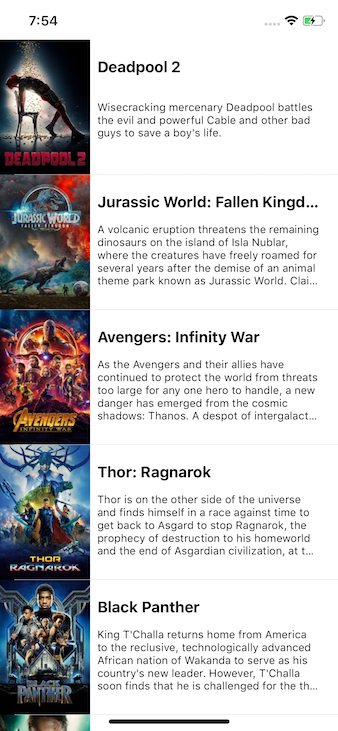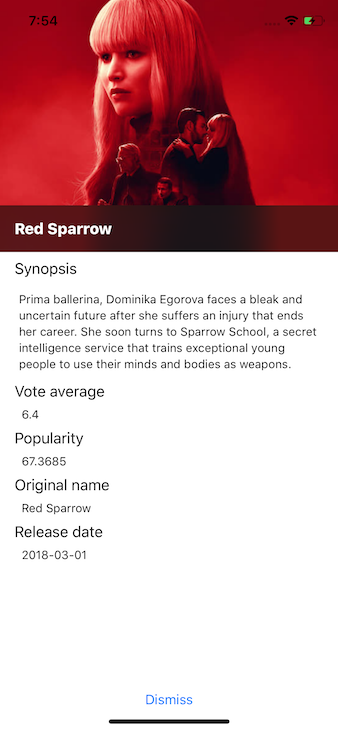 |
|
|---|---|
| Travis CI | |
| Frameworks |   |
| Platform |  |
| Licence |  |
RxReduce is a Reactive implementation of the state container pattern (like Redux). It is based on the simple concepts of state immutability and unidirectionnal data flow.
Since a few years there has been a lot, I mean a LOT, of blog posts, tutorials, books, conferences about adapting alternate architecture patterns to mobile applications. The idea behind all those patterns is to provide a better way to:
- meet the SOLID requirements (Wikipedia)
- produce a safer code by design
- make our code more testable
The good old MVC tends to be replaced by MVP, MVVM or VIPER. I won't go into details about these ones as they are well documented. I think MVVM is currently the most trending pattern, mostly because of its similarities with MVC and MVP and its ability to leverage data binding to ease the data flow. Moreover it is pretty easy to be enhanced by a Coordinator pattern and Reactive programming.
Go check this project if you're interested in Reactive Coordinators (RxFlow) 👌
That said, there is at least one other architecture pattern that stands out a little bit: State Container.
One of the most famous exemple is Redux, but let's not be restrained by a specific implementation.
Some resources about state containers:
The main goals of this pattern are to:
- expose a clear/reproductible data flow within your application
- rely on a single source of truth: the state
- leverage value types to handle the state immutability
- promote functional programming, as the only way to mutate a state is to apply a free function: the reducer
I find this approach very interesting compared to the more traditional ones, because it takes care of the consistency of your application state. MVC, MVP, MVVM or VIPER help you slice your application into well defined layers but they don't guide you so much when it comes to handle the state of your app.
Reactive programming is a great companion to state container architectures because it can help to:
- propage the state mutations
- build asynchronous actions to mutate the state (for networking, persistence, ...)
RxReduce:
- provides a generic store that can handle all kinds of states
- exposes state mutation through a Reactive mechanism
- provides a simple/unified way to mutate the state synchronously and asynchronously via Actions
In your Cartfile:
github "RxSwiftCommunity/RxReduce"In your Podfile:
pod 'RxReduce'The core mechanisms of RxReduce are very straightforward (if you know Redux, you won't be disturbed):
- the Store is the component that handles your state. It has only one input: the "dispatch()" function, that takes an Action as a parameter.
- The only way to trigger a State mutation is to call this "dispatch()" function.
- Actions are simple types with no business logic. They embed the payload needed to mutate the state
- Only free and testable functions called Reducers (RxReduce !) can mutate a State. A "reduce()" function takes a State, an Action and returns the new State ... that simple.
- You can have as many reducers as you want, they will be applied by the Store's "dispatch()" function sequentially. It could be nice to have a reducer per business concern for instance.
- Reducers cannot perform asynchronous logic, they can only mutate the state in a synchronous and readable way. Asynchronous work will be taken care of by Reactive Actions.
- You can be notified of the state mutation thanks to a Driver<State> exposed by the Store.
As the main idea of state containers is about immutability, avoiding reference type uncontrolled propagation and race conditions, a State must be a value type. Structs and Enums are great for that.
import RxReduce
struct DemoState: State, Equatable {
var counterState: CounterState
var usersState: [String]
}
enum CounterState: Equatable {
case empty
case increasing (counter: Int)
case decreasing (counter: Int)
case stopped
}Making states Equatable is not mandatory but it will allow the Store not to emit new state values if there is no change between 2 actions. So I strongly recommand to conform to Equatable to minimize the number of view refreshes.
Actions are simple data types that embed a payload used in the reducers to mutate the state.
import RxReduce
struct IncreaseAction: Action {
let increment: Int
}
struct DecreaseAction: Action {
let decrement: Int
}
struct AddUserAction: Action {
let user: String
}As I said, a reducer is a free function. These kind of functions takes a value, returns an idempotent value, and performs no side effects. Their declaration is not even related to a type definition. This is super convenient for testing 👍
Here we define 2 reducers that will be applied in sequence each time an Action is dispatched in the Store.
import RxReduce
func counterReducer (state: DemoState?, action: Action) -> DemoState {
var currentState = state ?? DemoState(counterState: CounterState.empty, usersState: [])
var currentCounter = 0
// we extract the current counter value from the current state
switch currentState.counterState {
case .decreasing(let counter), .increasing(let counter):
currentCounter = counter
default:
currentCounter = 0
}
// according to the action we create a new state
switch action {
case let action as IncreaseAction:
currentState.counterState = .increasing(counter: currentCounter+action.increment)
return currentState
case let action as DecreaseAction:
currentState.counterState = .decreasing(counter: currentCounter-action.decrement)
return currentState
default:
return currentState
}
}
func usersReducer (state: DemoState?, action: Action) -> DemoState {
var currentState = state ?? DemoState(counterState: CounterState.empty, usersState: [])
// according to the action we create a new state
switch action {
case let action as AddUserAction:
currentState.usersState.append(action.user)
return currentState
default:
return currentState
}
}Each of these Reducers will only handle the Actions it is responsible for, nothing less, nothing more.
RxReduce provides a concrete Store type. A Store needs at leat one Reducer:
let store = Store<DemoState>(withReducers: [counterReducer, usersReducer])Middlewares are very similar to Reducers BUT they cannot mutate the state. They are some kind of "passive observers" of what's being dispatched in the store. Middlewares can be used for logging, analytics, state recording, ...
import RxReduce
func loggingMiddleware (state: DemoState?, action: Action) {
guard let state = state else {
print ("A new Action \(action) will provide a first value for an empty state")
return
}
print ("A new Action \(action) will mutate current State : \(state)")
}A Store initializer takes Reducers and if needed, an Array of Middlewares as well:
let store = Store<DemoState>(withReducers: [counterReducer, usersReducer], withMiddlewares: [loggingMiddleware])RxReduce allows to listen to the whole state or to some of its properties (we may call them substates). Listening only to substates makes sense when the state begins to be huge and you do not want to be notified each time one of its portion has been modified.
First we pick the substate we want to observe (by passing a closure to the store.state() function):
let counterState: Driver<CounterState> = store.state { (demoState) -> CounterState in
return demoState.counterState
}
let usersState: Driver<[String]> = store.state { (demoState) -> [String] in
return demoState.usersState
}The trailing closure gives you the whole state of the Store, and you just have to extract the substate you want to observe.
Then subscribe to the substate:
counterState.drive(onNext: { (counterState) in
print ("New counterState is \(counterState)")
}).disposed(by: self.disposeBag)
usersState.drive(onNext: { (usersState) in
print ("New usersState is \(usersState)")
}).disposed(by: self.disposeBag)And now lets mutate the state:
store.dispatch(action: IncreaseAction(increment: 10))
store.dispatch(action: IncreaseAction(increment: 0))
store.dispatch(action: AddUserAction(user: "Spock"))Please notice that the second action will not modify the state, and the Store will be smart about that and will not trigger a new value for the counterState. This happens only because DemoState conforms to Equatable.
The output will be:
New counterState is increasing(10) (for the first action)
New usersState is [] (for the first action)
New usersState is ["Spock"] (for the third action)
As we can see, counterState has received only one value 👌
RxReduce is a lightweight framework. Pretty much everything is a protocol (except the Store, but if you want to implement you own Store it is perfectly fine since RxReduce provides a StoreType protocol you can conform to).
Lately, Swift 4.1 has introduced conditional conformance. If you are not familiar with this concept: A Glance at conditional conformance.
Basically it allows to make a generic type conform to a protocol only if the associated inner type also conforms to this protocol.
For instance, RxReduce leverages this feature to make an Array of Actions be an Action to ! Doing so, it is perfectly OK to dispatch a list of actions to the Store like that:
let actions: [Action] = [IncreaseAction(increment: 10), DecreaseAction(increment: 5)]
store.dispatch(action: actions)The actions declared in the array will be executed sequentially 👌.
Making an Array of Actions be an Action itself is neat, but since we're using Reactive Programming, RxReduxe also applies this technic to Observables. It provides a very elegant way to dispatch an Observable<Action> to the Store (because Observable<Action> is also an Action), making asynchronous actions very simple.
let increaseAction = Observable<Int>.interval(1, scheduler: MainScheduler.instance).map { _ in IncreaseAction(increment: 1) }
store.dispatch(action: increaseAction)If we want to compare RxReduce with Redux, this ability to execute async actions would be equivalent to an "Action Creator".
For the record, we could even dispatch to the Store an Array of Observable<Action>, and it will be seen as an Action as well.
let increaseAction = Observable<Int>.interval(1, scheduler: MainScheduler.instance).map { _ in IncreaseAction(increment: 1) }
let decreaseAction = Observable<Int>.interval(1, scheduler: MainScheduler.instance).map { _ in DecreaseAction(decrement: 1) }
let asyncActions: [Action] = [increaseAction, decreaseAction]
store.dispatch(action: asyncActions)Conditional Conformance is a very powerful feature.
A demo application is provided to illustrate the core mechanisms, such as asynchronicity, sub states and view state rendering.
 |
 |
RxReduce relies on:
- SwiftLint for static code analysis (Github SwiftLint)
- RxSwift to expose State and Actions as Observables your app and the Store can react to (Github RxSwift)
- Reusable in the Demo App to ease the storyboard cutting into atomic ViewControllers (Github Reusable)